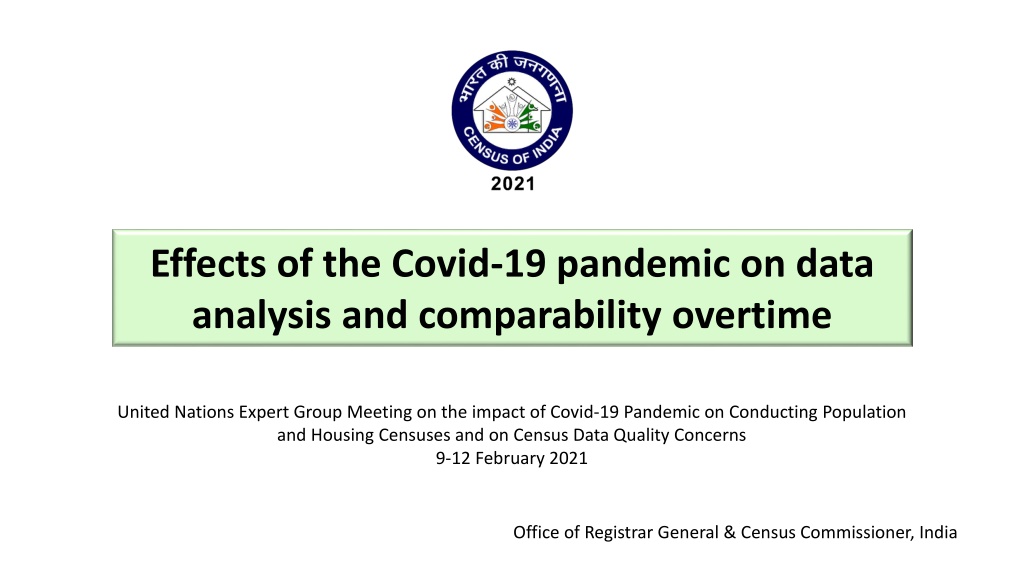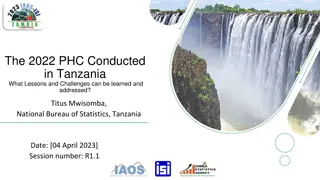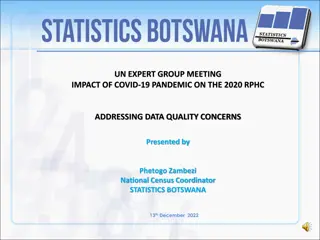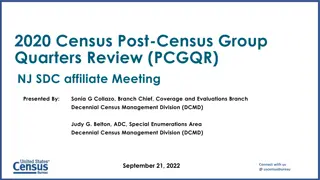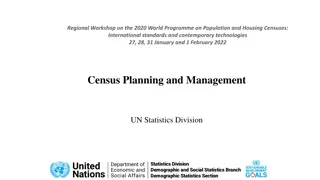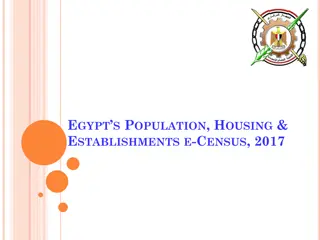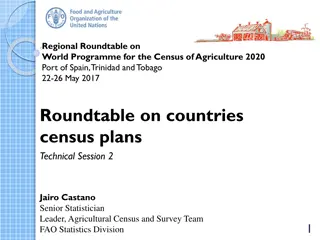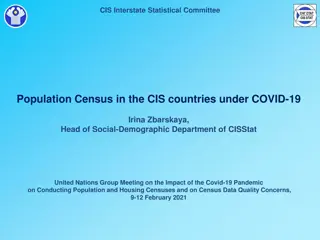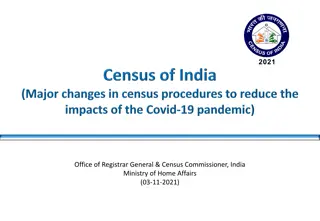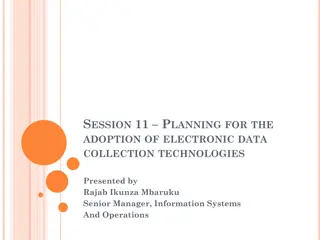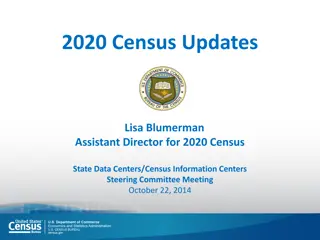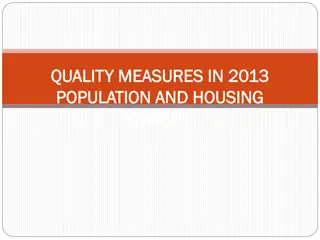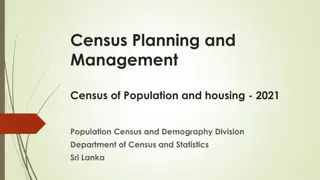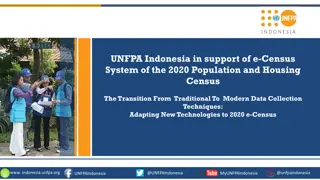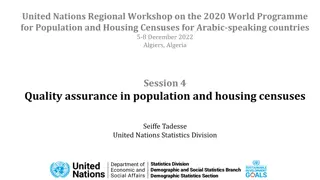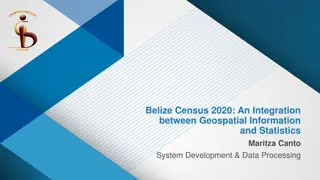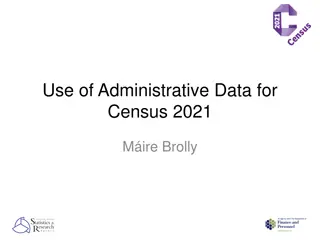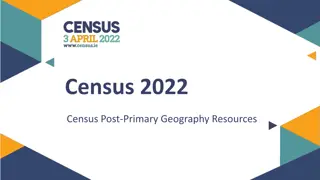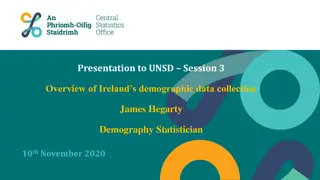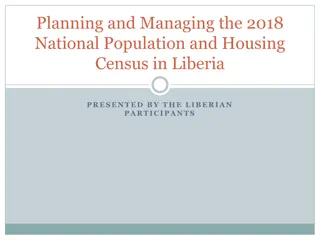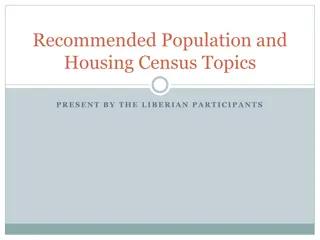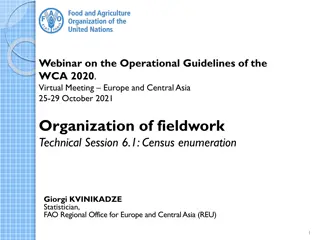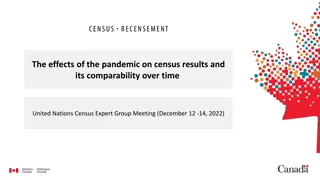Impact of Covid-19 on Census Data Analysis: Insights from the UN Expert Group Meeting
The Covid-19 pandemic has significantly affected data analysis and comparability over time, particularly in the context of population and housing censuses. This impact was discussed at the United Nations Expert Group Meeting in February 2021, focusing on the challenges faced in conducting these censuses and ensuring data quality. The Census of India serves as a vital source of comprehensive data, covering various aspects such as housing conditions, demography, urbanization, literacy, and economic activities. The legacy of the Indian census, which dates back to the 19th century, highlights its importance for policymaking and governance. With the upcoming Census of India in 2021, there are various logistical challenges and vast tasks ahead to ensure accurate and reliable data collection.
Download Presentation

Please find below an Image/Link to download the presentation.
The content on the website is provided AS IS for your information and personal use only. It may not be sold, licensed, or shared on other websites without obtaining consent from the author. Download presentation by click this link. If you encounter any issues during the download, it is possible that the publisher has removed the file from their server.
E N D
Presentation Transcript
Effects of the Covid-19 pandemic on data analysis and comparability overtime United Nations Expert Group Meeting on the impact of Covid-19 Pandemic on Conducting Population and Housing Censuses and on Census Data Quality Concerns 9-12 February 2021 Office of Registrar General & Census Commissioner, India 1
Outlines Introduction Legacy Vastness Calendar National Population Register Methodology Data collection using Technology Training Houselisting Questions Population Enumeration Questions Effects of the Covid-19 pandemic on Census Results Comparability with other Data Sources Major Challenges for comparison 2 Census of India 2021
Census of India Introduction Only source of primary data at village, town and ward level Biggest source of comprehensive data on: Housing Condition; Amenities & Assets Demography Scheduled Castes and Scheduled Tribes Urbanization Literacy & Education Language, Religion & Migration Economic Activity Fertility 3 Census of India 2021
Census of India The Legacy First non-synchronous Census conducted in 1865-1872 First synchronous Census conducted in 1881 (throughout the Country) Next census in 2021 (16th in the series and 8th since Independence) Census is conducted under Census Act 1948 and Census Rules, 1990 Utility : Delimitation/Reservation of Constituencies - Parliamentary/Assembly/ Panchayats and other Local Bodies 4 Census of India 2021
Census 2021 - Vastness States/UTs : 36 D I I F F U N C T I O N A R I E S I S C A N N I N G C P R I N T I N G U M L T A T R A I N I N G R M O T H E R T O N G U E S A P C E P E H R P O N I I P O A N L L L G E O S U P E R V I G Y F F D A T A P R O C E S S E D I T R U L E S I C U L T A R E A I N G Districts : 734 D I Census Charges : 18,000* I C O S T O T Villages : 6.5 lakhs* J I U R I S D I O N C T I O N B U T I O V U L N Towns/Cities : 8,000* C O Enumeration Blocks : 25 lakhs* S R A B L E E R A G E Enumerators & Supervisors : 31 lakhs* Questionnaires : 16 languages A W A R E N E S S Instruction manuals : 18 languages * Approximate numbers 5 Census of India 2021
Census of India Calendar Phase-1:Houselisting & Housing Census (HLO) and updation of National Population Register (NPR) April to September 2020 ( a period of 45 days as chosen by the State Govt.) 30 days for HLO and 15 days for updation of NPR Postponed due to outbreak of COVID-19 pandemic Phase-2: Population Enumeration (PE) 9th to 28th February 2021 1st to 5th March 2021 (Revisional Round) Data Dissemination Provisional population within 3 weeks HLO data 6 to 8 months PE data - Village-wise primary data within 1 year Other PE data and Finalization of NPR data within 2 years 6 6
National Population Register (NPR) updation NPR was first prepared in 2010 alongwith first phase of Census 2011 A few fields of NPR 2010 were updated and Mobile, Aadhaar and Ration Card number were collected during 2015 NPR updation exercise Now it has been decided to update NPR with Houselisting and Housing Census By linking NPR with registration of birth and death, real time population register will be available leading to register based census in future 7 7
Methodology Digital data collection i. Mobile App ii. Self Enumeration Enumerators to use their own device Management & monitoring through Census web portal (CMMS) Minimum descriptive entries through coded responses or ORGI Scanning Centre ORGI Server 8 8
Data Collection Using Technology Mobile App for Data Collection Mobile Apps and Web applications developed: i. Houselisting and Housing Census OFFLINE Mobile App ii. Mobile app for Geo tagging of Enumeration Blocks iii. Self-Enumeration web application for updation of NPR iv. National Population Register OFFLINE Mobile App v. Population Enumeration OFFLINE Mobile App powered with code- directories for descriptive entries vi. Self-Enumeration web application for Population Enumeration Apps in 16 languages in which Census is conducted. Internet availability required for registration of enumerator and uploading of data only. 9 9
Training Three tier structure of trainers to train 33,00,000 enumerators and supervisors 90 National Trainers Out of the 90 National Trainers 60 from ORGI and 30 from faculty of State Administrative Training Institutes (ATIs) 1,000 Master Trainers 43,000 Field Trainers 31 Lakh Enumerators & Supervisors Master Trainers will be mostly from States and some from Directorates of Census Operations All the 43,000 Field Trainers will be from States/UTs 10 Census of India 2021
Houselisting Questions 2021 Category Questions on Housing condition Material of floor, wall and roof Use & condition of house, ownership, no. of rooms, no. of married couples Amenities available Drinking water, Lighting, Latrine facility, drainage connectivity, bathing, kitchen,, fuel used for cooking Assets possessed Radio/Transistor, Television, Computer/Laptop Telephone/Mobile phone/ Smart phone Bicycle, Scooter/Motor Cycle/Moped, Car/Jeep/Van Access to Internet Other Main Cereal Consumed Mobile number 11 Census of India 2021
Population Enumeration Questions 2021 Category Questions on Category Questions on Economic Work status Main, marginal and non-worker Category of economic activity Occupation Nature of Industry Class of worker Non economic activity Seeking or available for work Mode of travel and distance to place of work Demographic Sex (M, F, Transgender) Date of Birth & Age Marital status Age at marriage Children born and surviving Socio-cultural Relationship to head Religion SC/ ST Disability Mother Tongue Other languages known Literacy status Educational level Stream/ Discipline Migration Birth Place / Place of last residence Reason for migration; Duration of stay since migration 12 Census of India 2021
Effects of the Covid-19 pandemic on Census Results The pandemic may effect following Census Measures: Migration Workers Fertility Population attending educational institutions Rural-Urban distribution of population Distance to travel place Access to internet Ownership status This effect may vary depending on the actual year in which Census takes place. 13
Comparability with other Data Sources Data set from Census Other data set available from sample survey/Administrative records etc to which census data may be compared Fertility Data Data from Sample Registration System (Data availability-Yearly) Workers data Periodic Labour Force Survey (PLFS) (Data availability quinquennial) Migration data Data from National Sample Survey Population attending educational institutions Decadal growth Data from Ministry of Education Backward interpolation Rural-Urban Distribution Post Enumeration Survey 14 14
Major Challenges for comparison of Census data with other data sources Difference in Concepts and Definition Methodology for data Collection Time gap between two data sources 15 15
Thank You http://www.censusindia.gov.in 16
